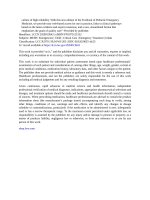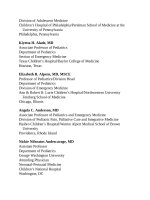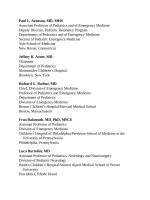Pediatric emergency medicine trisk 2723 2723
Bạn đang xem bản rút gọn của tài liệu. Xem và tải ngay bản đầy đủ của tài liệu tại đây (130.38 KB, 1 trang )
circumferential palpation. Do not perform a digital rectal examination or measure a
rectal temperature as it may increase the risk of bacteremia.
Diagnostic testing should include a CBC with differential and blood cultures from
all line lumens or via venipuncture in patients without a line. Institution-specific
guidelines should be followed regarding the need for peripheral blood cultures in
addition to line cultures, and if additional orders or specimens are needed for
anaerobic cultures. Additional diagnostic testing can be obtained as needed after
empiric antibiotics are started. A chest x-ray should be obtained in patients with
respiratory symptoms. A urinalysis is not valuable for screening for infection since
there are too few WBCs for the leukocyte esterase to be of value. A urine culture
should be obtained as long as it does not delay start of antibiotics or require
catheterization, which may also increase the risk of bacteremia. If the patient has a
history of urinary tract infections, the risk of urinary catheterization may be
justified. Throat cultures may be of value if there are focal findings involving only
the pharynx and/or tonsils but are rarely informative in a patient with diffuse
mucositis. Specific imaging may be of value based on physical findings. Viral
testing of vesicular lesions may identify varicella infections. Cultures of draining
abscesses or wounds may help guide antibiotic choice. Diarrhea should be tested for
C. difficile toxin.
Management
Antimicrobial treatment of suspected febrile neutropenia should be initiated within 1
hour of patient arrival with the institutional standard regimen. Therapy should be
directed against both gram-positive and gram-negative organisms, including
opportunistic pathogens ( Fig. 98.4 ). Specific coverage, in addition to empiric
therapy, is indicated for several clinical settings.
Third-generation cephalosporins may have inadequate gram-positive coverage for
patients with soft tissue site infections and consideration should be given to a
semisynthetic penicillin and an aminoglycoside or the addition of vancomycin,
given the rising incidence of MRSA. With evidence of sepsis, double coverage for
gram-negative organisms may be added in addition to vancomycin to cover for
possible Streptococcus viridans, especially in patients with advanced hematologic
malignancies. Fungal coverage is often considered for patients in shock.
Empiric antibiotics for suspected typhlitis include broad-spectrum coverage of
gram-negative enteric flora as well as specific anaerobic coverage and should be
started as soon as the diagnosis is suspected. Typical regimens are a carbapenem
alone or a combination regimen such as piperacillin/tazobactam with gentamicin or
ceftazidime with metronidazole. Laboratory studies should include coagulation
studies and lactic acid, as well as CBC with differential and basic chemistries to
assess hydration and renal function. Uncontrolled coagulopathy and/or acidosis are









